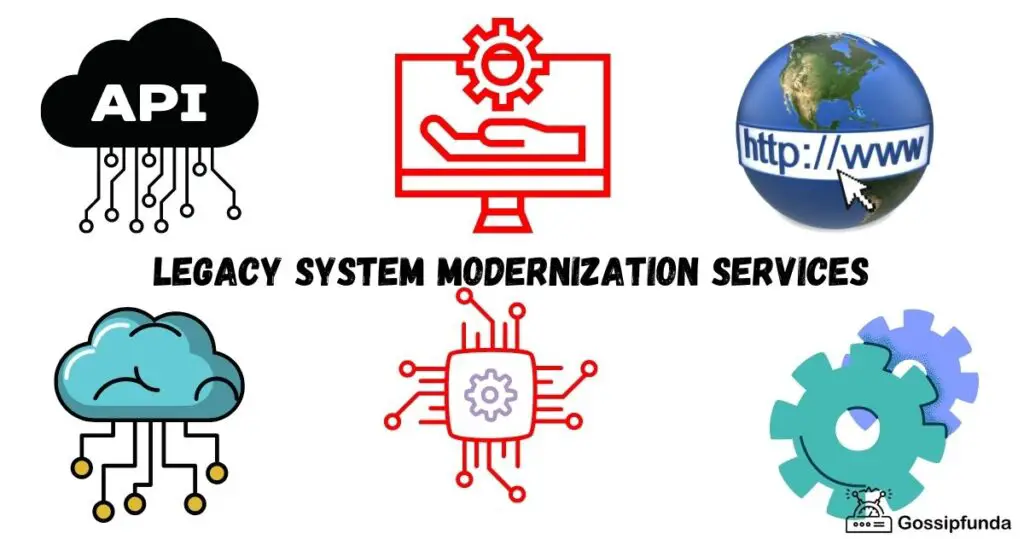Everyone tends to cling to the past much more than they should. The reason for this is that past is comfortable, familiar, we have experienced it for a long time and a drastic change from it scares us. But, in the modern world, mere sustenance let alone development is based on the ability and extent to which you are willing to change. The world is moving in a lightning speed when it comes to technology and if we don’t adapt to it, we might as well be aliens on our own planet. Legacy system modernization is the process where businesses shift towards the latest modes of technology rather than clinging to the existing ones. In this article, we will discuss more legacy system modernization, its strategies, advantages, and most importantly, various legacy system modernization services that you can avail of as per your needs.

What is a legacy system?
A legacy system is an antiquated technology that is still in use. It can be hardware or software. It can still be used for its originally designed purposes but is much farther away in development than the modern techniques. The continuing use of these technologies might cause various issues including high maintenance cost, data silos (unintegrated systems where each device has its own data silo), harder compliance, weaker security, and so on.
There are many reasons why companies still choose to use their legacy system. They include lack of investment, fear of change, and difficulty in unwrapping a whole new set of services.
What is legacy modernization?
It is basically modernizing the entire business to improve services in the areas of customer satisfaction, data integration, technical constraints by introducing advanced technology services.
Every company has three stages of technological development. The first one is growth where the legacy systems enact. Later on, there is a maturity phase where there is an overflow of work quality enhancing requirements and system maintenance. This will lead to an impasse where the businesses are confused or afraid to move to adapt to new technologies like Artificial Intelligence or Machine Learning. It is at this point where legacy modernization happens for the overall development of an enterprise and readiness for innovation.
The last phase, that is growth is fueled by the cutting-edge technology that provides provision for huge innovation and development.
Legacy modernization strategies
There are various approaches to legacy modernization ranging from simple changes in the legacy system showing no drastic drift to complete replacement of the legacy system with cloud-based tools. The two major strategies for legacy modernization are revolutionary and evolutionary modernization.
Revolutionary modernization:
It is the complete transformation of a business from legacy systems to modern technology. This usually happens in mergers and acquisitions when a company’s entire functionality has to be changed to embrace the new leadership. This strategy is also applied when the legacy system is no longer useful and is causing to be more of a threat. In that case, a business has to begin from scratch leaving all legacy systems behind.
Evolutionary modernization:
This method approaches the same goals as revolutionary modernization in a step-by-step manner. This is helpful to reduce disruptions and chances of risk in moving to completely new and unrelated technology. This is a slower but much effective and low-risk method.
Legacy system modernization services
Various companies across the world provide legacy modernization services to businesses. Their main aim is to transform your legacy system into modernized technology with the strategies that are best suitable for the situation of a company. In this section, we will see the major legacy modernization services provided by various companies.
Cloud Migration
Migrating to cloud services can be a huge step for many companies. There are many great benefits to cloud computing that will enable the smooth functioning of the digital sector. The benefits of a cloud-based system include:
Reduced IT costs:
The costs of the system up-gradation and new equipment can be reduced through a collective contract with your cloud service provider. In addition to that, extra payment for expert staff and energy consumption costs can be reduced.
Work flexibility:
Connecting data to various devices means accessing data anywhere. Features like work from home can be efficiently accomplished through cloud services.
Data continuity:
The safety of your data is of great importance in any business. Electronic devices can become faulty at any time but cloud services provide you with the essential backup so that all your data is safe even if there is an issue with your device or even office spaces.
When the cloud migration is done, your service provider will first analyze your existing system, its weaknesses, and flaws and avoid them in the new service. After the initial evaluation, a proper model suiting your business needs will be created. The cloud computing app will be optimized according to the initial model and a balanced IT budget.
Software audit and assessment
Assessing your legacy system software is a major step in modernization. In this service, the present state of your legacy system will be assessed and will be provided with a detailed report of the assessment.
There are many reasons for you to avail of this service. If you don’t have a clear understanding of your legacy application style, or you don’t know what modernization technique to adapt, then taking an assessment will be helpful. Also, the software audit and assessment can consider if your system quality is questionable or if there is a necessity to construct a stable software modernization strategy.
The types of legacy system audit done by various companies are provided below:
- Compliance audit: This is the audit that shows how much a solution fits regulatory guidelines.
- Functionality audit: This audit provides insight into whether the solution aligns with and works properly in the corresponding market needs.
- Security audit: This identifies any system vulnerabilities or data leakage in the system.
- Third-party audit: This gives an unbiased evaluation of the outdated app’s codebase.
Through this audit and assessment, any major concerns about your legacy system and modernization steps can be address.
Desktop to web migration
The desktop to web migration essentially means the transformation of a business’s core processes into a much more favorable and mobile environment. This can be done for the benefit of employees and customers alike. This transformation will ensure you better processing speeds, improved security, easily assessable business processes, and benefits faster innovation.
You can utilize the web to migrations services mainly due to the following reasons:
- If you cannot keep up with the user expectations.
- Your system is unable to handle the workload.
- You want a system that is agreeable with different devices.
- The maintenance cost for your legacy system is very high.
From providing traditional web hosting servers to the unification of apps and services can perform using this migration service. The transition from a desktop application to a mobile application can operate with ease and this will greatly benefit the user experience.
API Integration services
Business integration via API is a productive and efficient way to attain a fresh perspective without disregarding the real purpose of legacy systems. An application programming interface (API) acts as a messenger which delivers data and enables connectivity between devices and programs.
Thus, the API interface can create a channel for businesses to sell their products online. API integration benefits customers immensely, ensures faster growth and scalability to the company, and provides streamlined business processes.
The types of API integration services are given below:
- Private API: It integrates the complete functioning of an enterprise to have complete control over the distributed data services.
- Partner API: This service can be use to integrate business enterprises located in different locations. It promotes cooperation and collaboration within partner enterprises.
- Public API: A third-party API enables modernization with external interfaces and brings extra functionalities to end-users.
Architecture improvement services
The improvising of legacy system architecture is essential for many major performance enhancements. It offers many benefits including better system performance, efficient execution, reduced cost of cloud hosting, and so on.
The process of re-architecting the software system includes many steps. It starts with assessing the present system and planning the areas of its improvisation. A transitional architecture can be created and then the system is slowly implemented. Maintaining the overall system is the last and crucial step in this process.
So, after the transition, the entire company must be prepared for the new change by updating documentation, learning new system dependencies, revamp building plans for complete integration, and hiring new specialists.
Software re-engineering services
Re-engineering legacy services is a great way to approach software building without much risk. It requires translating the system source code into another language, restructuring database transfer, enhancement of software architecture, the addition of extra features, and integration Google API as well as third-party APIs.
When there is a drastic change in the technology that your company is currently using or if there is another technology that better matches your business requirements, then you can consider legacy software re-engineering.
There are many steps involved in the software re-engineering process. They are below:
- Step1: Inventory analysis where the identification of re-engineering candidates among software apps is done using certain basic criteria.
- Step2: Document restructuring where the documentation has to be restructured in certain parts.
- Step3: Reverse engineering where the analysis to recover the program design and its representation to a higher level than the source code occurs.
- Step4: Code restructuring by analyzing the existing system and fixing its flaws in the source code.
- Step5: Data restructuring by dismembering the current architecture to review data structures and define data process models
- Step6: Forward engineering to recover information from current source code and improving its quality and performance.
Conclusion
Considering thrift changes can be a difficult process. But it is a necessity in the fast-moving world.
User-friendly applications are the key to the new consumer world. As the customer lifestyle and requirements have taken a major shift, so should the business world. It is way past the right time to enhance your legacy systems to modern technologies.
Never try to duplicate another company’s modernization plan or the most famous plan. Customization is essential when it comes to modernization and hence, make sure to analyze your legacy system first to identify its flaws and points of improvement and then act upon forming a new system. Choosing the right legacy modernization strategy is as important as choosing the service. Hence, identify your need and conclude upon whether you need a drastic or incremental.

I am an Electronics and Communication engineering student from Kerala with a passion for tech writing. I enjoy challenging assignments that require my knowledge and skills. My technical skills include languages Python, C, C++, Arduino. Also, I have experience in Flutter development.


